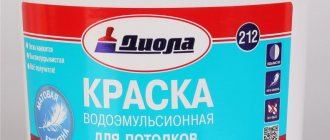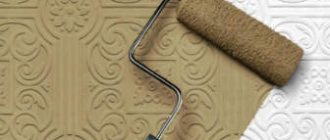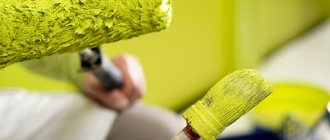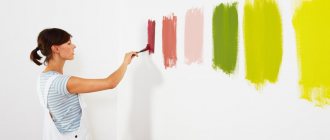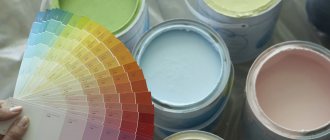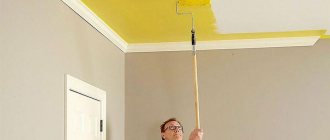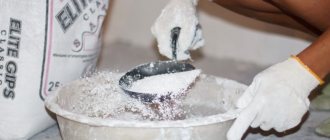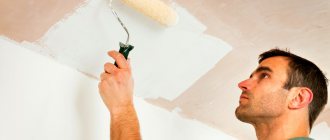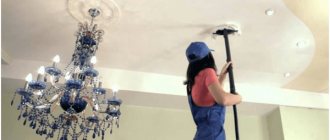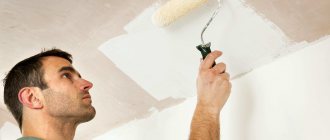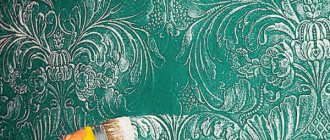Modern construction technologies make it possible to finish the ceiling in a wide variety of ways. While some are wondering which coating is best for the ceiling, most choose to paint with water-based emulsion. This is not surprising because water-based ceiling paint is still one of the best coating methods.
This is due to the relative simplicity of this method and low costs compared to other options. In addition, anyone can paint the ceiling in this way, even without special skills. The choice of water-based paint for the ceiling is always accompanied by the question: why this and not any other? Let's try to figure this out.
Specifications
To describe the water-based composition, the following factors are important:
- Paint components. The aqueous solution can contain a variety of fillers, thickeners, and antiseptic substances. Depending on the composition, the paint is intended for facade or interior work, wet or dry rooms, etc.
- Scope of use. The composition can be universal or for painting only one type of surface (for example, wood).
- Consumption of paint and varnish composition. The amount of paint in milliliters is calculated based on how much it is needed to cover 1 square meter in one layer. At the same time, many factors are taken into account, including the type of material and surface condition.
- Specific gravity. High-quality water-dispersion paint has a density of approximately 1.5 kg per 1 liter.
- Viscosity. This parameter indicates the degree of dilution with liquid.
- Ambient humidity during application and operation.
- Drying time.
- Storage conditions.
- Best before date.
- Service life of the coating.
There are other technical details to know, including the proportions of paint components and common markings.
Note! Water-based paint is always white, and colored paint is obtained by adding a special pigment.
Component proportions
An important component of water-based paints is the emulsifier, which is responsible for the formation of the film.
The following components are used as film formers:
- styrene-butadiene;
- acrylic resin;
- polyvinyl acetate;
- styrene acrylate.
Mica, barite, talc, and chalk are also added to the composition. The proportions in which certain components are contained in the paint are determined by its purpose.
The function of a thickener is performed by a complex compound - carboxymethylcellulose. In common parlance, this component is called CMC adhesive.
Note! To work with emulsion paint, it is recommended to use a spray bottle. Spraying allows you to get the highest quality and uniform coverage.
The table shows the ratio of various components in water-based paint:
Water-based paint and varnish material is made by adding a white pigment substance, for example, zinc oxide or titanium dioxide.
According to the main component, all water-based dyes are divided into several types:
- silicate;
- acrylic;
- silicone;
- mineral.
Marking
Abbreviated letters and numbers are used on the paint can or in accompanying documents. First there are letters indicating the type of composition:
- VE – water-based paint;
- VD – water-dispersed.
The following letters indicate the type of polymer used:
- KCh (butadiene-styrene);
- VA (polyvinyl acetate);
- AK (acrylate or styrene acrylate);
- VS (polyvinyl alcohol).
In addition to letters, numbers are used:
- 1 - compositions that are especially resistant to atmospheric conditions;
- 2 - paints for interior work.
Note! Requirements for water-based coatings are set out in GOST 281960-89. Unlike GOST, the rules of technical specifications are much less stringent, and therefore the quality of products manufactured according to technical specifications cannot be guaranteed.
Advantages and disadvantages
Water-based paints have many positive qualities:
- Good adhesion to different types of materials.
- Easy to dilute in water.
- Environmental Safety.
- Fast drying.
- No unpleasant odor in the room after painting the surface.
- Strength. The coating does not peel off.
- Resistant to chemicals, including alkalis.
- Easy to remove dirt from the coating.
- Fire safety.
- High water resistance of individual modifications, which makes it possible to paint surfaces in bathrooms and kitchens with such compositions.
- Antibacterial properties.
- Long service life of the coating, reaching 18-20 years.
- The ability to mask surface defects (with the proper level of viscosity of the composition).
- Compatibility with any type of interior. Thanks to tinting, the paint has a wide range of colors.
- Low cost.
Water-based paints also have disadvantages:
- Temperature sensitivity when dyeing. The minimum threshold is 5 degrees above zero.
- Some types of paints do not form very durable surfaces.
- Not all water-based compounds are suitable for metal substrates or glossy surfaces.
Main characteristics of water-based paints
Any water-dispersion paint for the ceiling, regardless of its type, has a number of characteristics that determine the performance qualities of the finishing material:
- Mass fraction of non-volatile substances
. This parameter indicates the mass of the substance, due to which the direct formation of the coating is ensured after the volatilization of all evaporating components. This parameter should exceed 40%, and the value directly affects the quality of the coating and the economy of the composition - with a high proportion of residual mass of substances, fewer layers will have to be applied. - Frost resistance
. This parameter expresses the resistance of the material to low temperatures. The indicated value means that the paint, after application, will withstand a certain temperature without reducing quality.
- Resistant to constant exposure to moisture
. This indicator shows how many hours the coating can withstand constant contact with water. This indicator is measured at temperatures from 18 to 22 degrees. - Grinding degree
. This parameter determines the maximum particle size of the substances that make up the paint. Compositions with small particles adhere much better to the surface and form a smooth film. - Covering power
. The hiding power index is the consumption of water-based ceiling paint per square meter of surface to be coated. This indicator assumes that the entire area will be covered with an even layer of paint without noticeable defects.
Types of paint
There are several types of water-based paints and varnishes.
Polyvinyl acetate
The most affordable in terms of money. Advantages also include resistance to ultraviolet radiation and grease stains. These paints are non-toxic and fireproof. However, polyvinyl acetate dyes are not resistant to moisture, and over time, coatings made from them turn yellow.
Mineral
Contains calcium hydroxide and cement. The main advantage of mineral coatings is also their low cost. Best suited for painting concrete and brick. They are characterized by increased vapor permeability and resistance to temperature changes. However, coatings quickly change color and are not resistant to mechanical damage.
Silicate
The main component is liquid glass. Advantages: financial affordability, durability, mechanical strength, resistance to temperature changes and vapor permeability. Disadvantages: suitable only for painting concrete and plaster indoors, as they are not resistant to moisture. In addition, silicate paints and varnishes do not adhere at all to metal and glass surfaces.
Acrylic
Acrylate-based paints are the most popular today. They are versatile and can be used to paint any type of surface. However, before painting the metal, you will need a high-quality primer. Advantages: resistance to ultraviolet radiation, mechanical stress, dirt-repellent properties, elasticity. An important quality of acrylic paints is their low consumption rate. Another advantage: a washable surface painted with acrylic paint can be used both outdoors and indoors with equal success.
Latex
This type of paintwork material is based on latex. Due to this, the cost of paints is high. Latex gives the coating excellent moisture resistance. Such surfaces can be washed even with aggressive detergents. Latex paints are suitable for treating all types of surfaces. A characteristic feature of latex solution is its ability to mask surface imperfections.
A significant disadvantage of latex paint is the lack of vapor permeability, which causes condensation to appear on the coating. In addition, latex is not resistant to sub-zero temperatures, ultraviolet radiation and fungus.
Silicone
The main component is silicone organosilicon resins. They are especially often used when painting ceilings. This is due to good paint adhesion, due to which no streaks form on the ceiling during the painting process.
Due to its high viscosity, silicone paint masks small surface defects. This base allows you to achieve an antiseptic effect, high vapor permeability, resistance to chemicals and fungal formations. In this regard, coatings are popular when finishing wet rooms.
Due to their excellent adhesive characteristics, silicone compounds are often applied to old paint layers. The high density and hiding power of the material allows you to get by with a couple of layers even when painting a black surface.
Classification of paints by purpose and type of coating
Water-based compositions are distinguished by purpose (information about this is contained on the label):
- For dry rooms with low operational load. These paints are not suitable for wet rooms. This type of water-based emulsion is not the best option for a child’s room either, since the coating cannot be washed.
- Resistance to mechanical loads. Similar markings are used for paint and varnish compositions that form abrasion-resistant coatings, but are susceptible to moisture. The surface may only be cleaned with a dry brush or vacuum cleaner, but not with water.
- Indelible coating. Paints with this marking are used in rooms with high levels of humidity or in rooms where there is a need for frequent wet cleaning. However, be careful not to work too hard with a damp cloth, as the coating is not abrasion resistant.
- Dirt-resistant. Coatings of this type are among the most durable, resistant to wet cleaning even with the use of aggressive chemicals. You can choose dirt-repellent paint if the coating is intended to be used in conditions of high humidity or constant contamination.
- Interior. Paint is labeled with the word “interior” if it is intended for use only inside a building.
- For the ceiling. The peculiarity of ceiling paint is that it has a more liquid consistency compared to coatings for walls or floors.
There are three types of coatings:
- Glossy. A shiny surface allows you to visually enlarge the space and create the feeling of a high ceiling. Glossy coatings are not afraid of wet cleaning and are resistant to abrasion. However, any defects (cracks, chips, etc.) are noticeable on them.
- Matte. Unlike glossy ones, matte coatings do not withstand wet cleaning. However, on a matte background, minor surface imperfections are practically invisible.
- Semi-matte. This type of coating is something between matte and glossy.
Advantages of water-based paint
Water-based paints have a number of advantages over analogues:
- The material is based on water, thanks to which the paint does not have the characteristic chemical smell. This quality makes it possible to use water-based emulsion even indoors - harmful vapors will not accumulate in the air.
- This type of paint has a very high drying speed. For the water-based ceiling paint to dry completely, one day will be enough.
- Water-based paint, when applied in several layers, creates a coating about 1-2 mm thick. Due to this, it is possible to hide the smallest cracks and damage to the ceiling. If this issue is fundamental, then it is best to use matte paints. Glossy compounds require additional sanding after application.
- Even an inexperienced craftsman who has no experience in painting and varnish work can work with water-based paint.
Popular manufacturers
There is a wide variety of water-based compositions on the market. The best quality products are produced by European manufacturers such as Tikkurila, Dulux and Dufa. Products from well-known brands are expensive, but have excellent consumer characteristics and a proven reputation. Inexpensive paints from little-known companies are not always synonymous with low quality, but before purchasing, it is recommended to study reviews of such products on the Internet.
Stages of work
In addition to the ceiling treatment process itself, there are a lot of different things that should be done first. The first thing you need to do is prepare the room.
First, you should take out all the furniture you can. If it is not possible to do this, then it should be covered with film, which is sold in hardware stores.
It is necessary to carefully secure the film with tape or any other means. The floor should either be covered with newspapers and paper, or also covered with film.
Next comes the preparation of the tools necessary for the job. This list will include:
- Rollers
- Brushes
- Masking tape
- Protective glasses
- Special clothes, or those that you don’t mind getting stained with paint
- Bath or cuvette
- Hand wiping cloths
- Sandpaper or a special grater (if the ceiling will be leveled)
After changing clothes, you can begin preparing the work surface. It is necessary to remove old coatings, dust and other contaminants. If necessary, you need to level the surface with putty, then allow it to dry thoroughly.
The walls along the junction with the ceiling are covered with masking tape so that the paint does not stain them. After all the work has been completed, the tape can be easily removed.
After leveling and cleaning the ceiling with sandpaper or a special grater, you can begin priming the ceiling. It is still better to use a primer, although many are in a hurry and miss this important point. It is important not only because the coating will adhere better; when painting primed surfaces, the material consumption will be less, which means there will be savings.
After the primer layer has dried, the paint itself is checked. If it is too thick, you can dilute it a little with water. Other types of dyes are diluted differently, and water can only be used for water-based mixtures.
Having thoroughly mixed the contents of the jar, pour a little into the cuvette where the roller will be dipped. A detail such as a roller for painting the ceiling is very important. It should be approximately 20 - 25 centimeters wide. This size will be optimal, which has been repeatedly tested in practice.
It is better to take a fluffy roller. Foam rubber is definitely not suitable - it leaves bubbles on the surface, and velor foam will have to be dipped into a ditch too often - it absorbs very little.
It's time to start coloring. The first is to apply a layer of paint diluted in half with water. When it starts to dry, all the flaws in the leveling of the ceiling surface will appear. They need to be removed by rubbing with sandpaper.
Next, the first layer is laid down.
The first layer must be applied so that it runs parallel to the light entering the room. The second layer will go across it, and the last, final layer will go along the light again.
It is better to choose the corner opposite the front door as your starting point for work. First, use a brush to paint a strip along the walls and in the very corner.
After this, painting of the ceiling begins directly with a roller.
Painting is not difficult, the main thing is not to make the layer of paint applied too thick. This will help avoid the appearance of noticeable boundaries between areas painted at different times, and will make the applied coating more even.
If the work area is large, then you can process it gradually, square by square. Alternating layers, as mentioned earlier. Thus, any surface area can be treated.
Each layer should be given time to dry. It may be different for each type and manufacturer of paints and varnishes, so it is worth reading the instructions written on the packaging.
Surface preparation
In order for the paint to adhere well to the base coat, it must be carefully prepared. We are talking about removing irregularities, sealing cracks and cleaning the surface from dirt and dust.
During the preparatory work, a considerable amount of debris may arise, and when painting, it is easy to stain surrounding interior items. To avoid damage to property, use plastic film, which is attached to the baseboards using masking tape.
Surface cleaning
First you need to clean the walls of old paint or any other decorative coating. To remove paint, use one of three methods:
- Mechanical.
- Chemical.
- Thermal.
Note! Oil-based paint coating is incompatible with water-based paints, so it will have to be removed in any case. If the old paint is enamel, you can leave it, but prime the surface with drying oil.
Standard steps for surface cleaning:
- Remove the old coating using a stiff sponge or brush.
- If the wall is whitewashed, moisten it with water and remove the remaining whitewash with a brush or regular sponge.
- If we are talking about oil paint, we use a hair dryer to heat up the coating - this is the only way to soften it and remove it with a scraper or spatula.
There are commercially available products for chemically removing old paint from surfaces. Such chemicals destroy the previous coating, so that after some time after their application, all that remains is to remove the remaining paint mechanically.
Sealing cracks
When the walls are cleaned, we begin to find and seal cracks in the base coating. If you ignore this work, you will not be able to obtain a stable new coating and new cracks will inevitably appear on the painted surface.
We slightly widen the found cracks to fill them with a repair compound, using a spatula or a grinder. Next, we clean the cracks from dust and apply a deep penetration primer for painting. Let the material dry (most often we are talking about 4-6 hours of waiting).
The next step is to seal the cracks with putty or some kind of polymer (for example, silicone sealant). To prepare the putty, use an electric drill with a mixer attachment. The composition must be brought to complete homogeneity, only then is it considered ready.
Once the walls have dried after puttying, treat them with a primer again. Again, wait for the surface to dry before continuing to work.
Which water-based emulsion to choose?
When choosing a material for painting a ceiling, every owner of an apartment or house should remember the axiom: the best option is water-based paint. This is due to a number of undoubted advantages that it has compared to others:
- Absolutely harmless to humans and do not require special protective measures when performing work. Water emulsions do not emit harmful toxins or odors.
- Can be easily tinted using pigments specially designed for water-based emulsions. It is enough just to thoroughly mix the paint with the selected color.
- If water emulsion gets on furniture, the floor, or gets your hands dirty, you can immediately wash it off with plain water.
Therefore, the main problem that a person will face is which water-based paint is best to choose for painting the ceiling.
When choosing which ceiling paint is the best water-based paint, you need to focus on the following initial data:
- type of room;
- terms of Use;
- required appearance;
- available budget.
Therefore, in order to choose the right paint for the ceiling, you need to correctly assess the future operating conditions of the room. If you plan to paint the ceiling in an apartment or house in an ordinary living room in the absence of humidity and temperature changes, as well as with good preparatory finishing of the surfaces to be painted, then ordinary polyvinyl acetate or silicate water-based paints will be a sufficient option. This will save money, especially if the painting area is large.
In rooms with high humidity (bathroom, kitchen), as well as in rooms at risk of moisture penetration (upper floors, corner rooms), acrylic or latex ceilings are a good option. Also, latex-based paints have the best glossy effect. The cost of such paints will be higher.
If the surface to be painted is not well prepared, and you also want to make the most of the benefits of water-based emulsions, then it is better to choose silicone paint. Using the above recommendations, you will not get lost when searching for the answer to the question of how to choose the right method of painting the ceiling.
How to paint a ceiling (2 videos)
Water-based paint of different brands (28 photos)
Preparing the Paint
Dilution of paint
The paint in the can has a thick consistency. The undiluted composition is excellent for creating relief compositions, but it is too thick for regular painting. In this regard, the emulsion is first thoroughly stirred, and then water is added to it. The quantity is determined based on the recommendations of the manufacturer or empirically. Water is added until the paintwork reaches the desired consistency. Properly diluted paint resembles the density of full-fat milk.
If you plan to use a spray gun, tap water will not work, since after the coating dries, a whitish coating will form on it. In this regard, distilled water or alcohol is used for dilution.
The paint must be diluted immediately before use. After 15-20 minutes the composition thickens. If this time is missed, the paint should be diluted again.
Tinting
The water-based composition is offered in white. If you want to give the paint a different color, add pigment to it. This can be done at home or directly in the store, if they have specialized equipment.
If you do the tinting yourself, it is recommended to purchase pigment with a reserve of 10-15%. This will allow you to recreate the composition to renew the coating without any problems in the future.
The color is added gradually, after which the solution is thoroughly mixed. If the intensity of the resulting shade is not satisfactory, then you need to add more pigmenting substance.
First, you should dilute a little tinted paint, which will allow you to see how it will look on the painted surface. Moreover, the shade of the dried coating differs from the color of the liquid coating. You also need to keep in mind that paint that has expired or has been stored incorrectly may have a significantly different color (compared to the original) and have poor adhesion to the surface. Poor quality paint forms a bubble coating or simply runs off the surface completely.
Paint consumption
The approximate consumption per m2 is indicated by the manufacturer on the can. Based on these data, it becomes possible to plan the consumption of paints and varnishes.
You can also calculate the amount of paint needed based on the General consumption standards for water-based paints and varnishes:
However, it should be remembered that consumption rates for 1 m2 of the same paint can vary greatly depending on additional factors. In particular, we are talking about the type of material being painted. A smooth surface absorbs 15-20% less paintwork compared to a rough surface.
Note! When calculating, the number of layers is taken into account. Most often, one layer is not enough to paint the surface - you will need at least 2-3.
The material consumption is also affected by the tool used. For example, using a spray gun allows you to reduce the consumption of paintwork materials, but only if painting is carried out in calm weather.
Consumption also depends on air temperature and humidity. In hot weather, the liquid quickly evaporates from the dye, and therefore the coating is formed unevenly and layers have to be reapplied. Additional losses of paintwork materials are a common occurrence when painting a ceiling, since the composition simply flows down.
Tools
To apply paint use brushes, rollers or sprayers. Brushes are the best option for finishing small surfaces with many corners and convex details. A spray bottle is a convenient tool, but not everyone has it, and buying it for one painting is not always advisable. Therefore, a roller is often the best method for painting a surface.
There are several types of rollers:
- Foam rubber. They are characterized by low cost. They absorb too much dye, causing bubbles and unevenness to form on the coating.
- Velor. They are more difficult to buy due to their lower prevalence. Velor rollers are characterized by low absorbency. This property has a positive effect on the quality of painting, but you will have to dip the roller very often.
- Fleecy. The best option for painting. There are rollers on sale with different lengths of pile (affects the thickness of the layer). The most expensive fleecy rollers are made from felt and fur. Polyamide fiber rollers are also a good choice.
Useful little things
- Paint consumption is indicated by the manufacturer on the packaging. On average it is 150-250 grams per square meter when applying two layers.
- If you are tinting paint for a room, mix a volume 10 percent higher than calculated . Overspending is always possible, and it is usually unrealistic to achieve the same shade when re-tinting.
When tinting, mix the paint with a small margin.
- If you are offered paint at a price below 30 rubles per liter, most likely its quality is below any criticism. Pigments and polymers are imported from Europe, and their prices are constant for domestic and foreign producers. It is possible to achieve a serious reduction in cost only by neglecting the correct production technology.
- Water-based paint must be stored at temperatures above zero . After freezing and defrosting, it will lose its quality characteristics.
- It is necessary to paint with water-based emulsion at a temperature not lower than +5C. Otherwise, the thickening paint will lie unevenly and in a thick layer.
- Ceiling paint requires sanding each layer after application to a wooden surface. Unlike other paints, water-dispersed paints raise the wood pile.
- Paints that provide a glossy surface are more resistant to abrasion. Matte paints cannot be washed frequently (see Glossy ceiling paint: characteristics and methods of application).
- The best color for white paint is titanium dioxide. The water-based emulsion painted with it has a pure white color without any shades.
- It is common practice to use diluted water-based paint as a primer. However, it is not economically feasible: with comparable quality, primer is much cheaper than paint.
Primer is cheaper than paint. At the same time, it will significantly reduce its consumption and make the coating more durable.
Applying paint
The prepared paint and varnish material is poured into a painting tray. To make painting more convenient, reaching to the most remote areas, a long handle is attached to the roller. For this purpose, use a plastic tube or a light wooden holder.
Apply paint starting from the corner of the wall. Moreover, it is painted over with a brush. Then they dip the roller into the paint, press it onto the pallet and make movements downwards and then up. The thickness of the applied strip is equal to the width of the roller. Each subsequent strip is overlapped with the previous one. In this way, visible boundaries between the stripes are avoided. You need to paint quickly in order to have time to use up all the diluted paintwork.
Apply 2-3 layers of water-based composition to putty walls. Each time they wait until the coating dries, and only then begin to apply a new layer. On average, the break is 3-4 hours.
Note! When applying paint to wallpaper, one layer is enough.
Decorative painting
If you wish, you can not just paint the wall or ceiling, but draw a picture or patterns. To do this you will need a shaped roller, a stencil and masking tape.
Note! Decorative painting is carried out after the base layer has dried.
They work with a figured roller in the same way as with a regular one. There is a wide variety of patterns and textures, to choose which you just need to change the stencil. You can buy it in a store or make it yourself. The purchased stencil comes with instructions that indicate the colors for all its segments.
Advice! When using a stencil, do not press it too hard onto the surface, as this will result in drips.
Masking tape will be needed to create geometric designs. They cover that section of the wall that currently does not need to be painted. Then the tape is removed and a layer of paint is applied to the freed surface. Thanks to the tape, it is possible to avoid paint getting into unwanted places. It is removed only after the paint layer has dried to prevent drips.
Painting the ceiling
Before painting the ceiling with water-based paint, you need to prepare the following tools:
- A roller with a long pile, necessary for applying paint to large areas (due to the long piles, proper absorption of a large amount of the water-based composition is ensured);
- A brush that allows you to carefully paint joints and seams in the ceiling structure;
- Small brush for spot painting;
- Container for rolling out paint rollers.
Applying paint to the ceiling surface must comply with a number of rules. So, if there is one window in the room, the first layer of paint must be applied parallel to the window opening, and the second - perpendicular, and you need to start from the side of the window. If there are two windows in the room, then the layers should be applied perpendicular to each other, gradually moving from the window towards the blank wall.
It is best to start the painting process itself from a corner area located at the maximum distance from the front door. First of all, the joints are coated with a brush so that the width of the strip does not exceed 5 cm. Then the same surface will need to be painted again using a roller.
Separate layers are applied at intervals of at least 8 hours - this is enough time for the paint to dry completely. This process cannot be accelerated by artificial methods - in this case, the properties of the paint will be impaired and the coating will not be of sufficient quality. Of course, no owner will strive for such a result.
Individual layers must be applied carefully but quickly. The thing is that a fresh layer of paint always stands out against the background of an already hardened one, so it is advisable to make an effort and avoid possible contrast so that the ceiling looks quite beautiful after all the work is completed.
Popular questions
- How to remove water-based paint? Water-based paint can be washed off with water, removed mechanically (using a drill) or thermally (using a hair dryer). Paint can also be removed using chemicals (a mixture of vodka with salicylic acid or iodine with soap solution.
- Is it possible to glue wallpaper on water-based paint? The wallpaper will stick well to the surface of a water-based paint and varnish material. However, gluing should only be done if you are sure that the coating adheres well to the wall. In the worst case scenario, the old layer of paint may peel off along with the wallpaper.
- Is it possible to paint with water-based paint on enamel? If the old coating is enamel, it can be left if the surface is properly primed with drying oil. However, it is best to remove the enamel.
- Is it possible to paint the ceiling with water-based paint over old paint? This depends on the type of paint that was used to paint the ceiling. If we are talking about an old coating not made of water-based paint, in most cases it needs to be removed.
Choosing paint for the ceiling
To choose the most suitable water-based paint for a particular situation, you should use the following recommendations:
- First of all, you should pay attention to paints from well-known brands that have stood the test of time. The most popular products are Tikkurila, Caparol and Dulux.
- To finish the ceiling, you need to select a composition for the appropriate purpose. Ceiling paints do not drip or spread when applied. In addition, such materials have a much higher hardening rate.
- To bring the paint to the desired shade, you can do the necessary work yourself using coloring. In this case, it is worth mixing the paint so that in the end its amount exceeds the required amount by at least 10% - this reserve can be used in the future to update the coating. However, tinting often turns out to be too complicated for inexperienced craftsmen, and in this case it would be best to turn to specialists who have special equipment that allows them to mix the paint properly.
- All water-based paints contain water. Water freezes at subzero temperatures, causing the paint to lose its existing properties. To avoid encountering such problems, you should not purchase this finishing material in stores with unheated warehouses or on the market. However, it would be best to simply go to a specialized store and buy paint there - in this case, there is a guarantee of proper storage of the material and the absence of the likelihood of it being counterfeited.
- Don't discount the price factor. High-quality paints are more expensive, but their consumption during the finishing process will be less - i.e. Some of the funds will eventually pay for themselves.
By following these recommendations and correctly assessing the parameters given in them, you can choose a good paint that will adhere well to the ceiling throughout its allotted service life.
